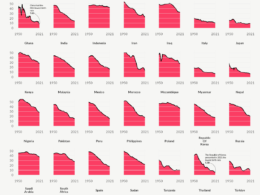Health and Tech Institute
strategy for continuous transformation
Joaquim Cardoso MSc
Chief Researcher and Strategy Officer (CRSO),
Editor in Chief, and Senior Advisor.
June 1, 2023
Key Takeaways:
- Global fertility rates are declining, leading to a potential population shrinkage by the end of the century.
This decline is a result of a slump in births rather than a surge in deaths.
- The fertility rate in many countries is already below the replacement rate of 2.1 births per woman. This includes not only the rich countries but also populous nations like China and India.
- Aging populations are becoming a common phenomenon, with countries like Japan, Italy, Brazil, Mexico, and Thailand facing the challenges of an increasing number of elderly citizens.
- A shrinking population presents economic difficulties, particularly in supporting pensioners. The ratio of workers to pensioners is decreasing, leading to implications such as higher taxes, delayed retirements, lower returns for savers, and potential government budget crises.
- Collapsing fertility rates have implications beyond economic challenges. Younger people possess greater “fluid intelligence” and creative problem-solving abilities, which contribute to innovation and economic growth. Aging societies tend to be less entrepreneurial and more resistant to change.
- Low fertility rates should not necessarily be viewed as a crisis.
They often result from increased individual choice, better work-life balance, and improved opportunities for women.
Populist calls for a return to traditional family values are misguided.
- Increasing immigration is not a sufficient solution to the global fertility slump. While immigration can help address worker shortages in individual countries, the global decline in fertility suggests a potential shortage of young educated workers in the future.
- Economic development and improved education in developing countries, particularly in rural areas, can help address the shortage of educated young workers without relying solely on increased birth rates.
- Advances in artificial intelligence (AI) and robotics could potentially alleviate the economic burden of supporting an aging population. AI-driven productivity gains and innovations in elderly care can contribute to sustaining a larger proportion of retired individuals.
- Throughout history, unexpected technological advances have helped overcome demographic challenges. Human ingenuity and innovation have the potential to address the consequences of declining birth rates and support economic growth.
Long version published at
Global fertility has collapsed, with profound economic consequences (economist.com)
DEEP DIVE

Global fertility has collapsed, with profound economic consequences
What might change the world’s dire demographic trajectory?
The Economist
Zanny Minton Beddoes, Editor-in-chief
June 1, 2023
In the 250-odd years since the Industrial Revolution the world’s population, like its wealth, has exploded.
- Before the end of this century, however, the number of people on the planet could shrink for the first time since the Black Death.
- The root cause is not a surge in deaths, but a slump in births.
Across much of the world the fertility rate, the average number of births per woman, is collapsing.
- Although the trend may be familiar, its extent and its consequences are not.
- Even as artificial intelligence (ai) leads to surging optimism in some quarters, the baby bust hangs over the future of the world economy.
In 2000 the world’s fertility rate was 2.7 births per woman, comfortably above the “replacement rate” of 2.1, at which a population is stable.
- Today it is 2.3 and falling.
- The largest 15 countries by gdp all have a fertility rate below the replacement rate.
- That includes America and much of the rich world, but also China and India, neither of which is rich but which together account for more than a third of the global population.
To continue reading: https://view.e.economist.com/












